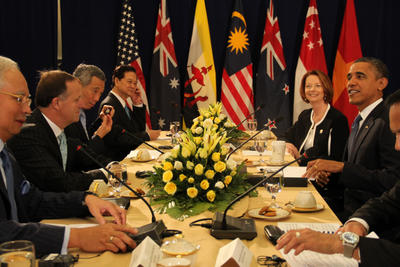Both these initiatives are part of the ASEAN+3 process, as is the Asian Bond Markets Initiative, designed to increase local currency issuance and thereby reduce the currency and maturity mismatches that exacerbated the impacts of the AFC. So far, these initiatives have met with mixed success, but it is early days still. At the very least, they are not doing any harm, and the region is better off for having them than not.
The same cannot be said about developments relating to trade policy.
Asia is a relative late-comer to negotiating so called free trade agreements (FTAs), but the region has been making up for it over the past decade or so. As of September 2012, there were 103 FTAs in effect involving one or more countries from the region, most of them bilateral. There are another 26 signed FTAs, 64 under negotiation and 60 more proposed. Most of the global action on FTAs now involves an Asian country.
If the sheer numbers are mind boggling, add to this the complexity introduced by rules of origin that can vary across FTAs, and just about any item that is up for negotiated liberalisation. This is more than a noodle bowl — it is the mess that is left behind when the noodle bowl crashes to the floor!
Where do we go from here? Left unchecked, the number of FTAs is poised to increase. A speedy and legitimate conclusion to the Doha Round might help, but is this likely? There is renewed discussion of sectoral agreements on trade facilitation and other issues, which may substitute, some argue poorly, for conclusion of the Round. The so-called cherry-picking approach of sectoral agreements seems the likely outcome in breaking the deadlock of overly demanding all-or-nothing ‘single undertakings’.
The current situation with FTAs suggests that Doha alone may not be sufficient, even if concluded comprehensively, and certainly if sliced up into sectoral agreements. Against this backdrop, two key proposals are being put forward to deal with the so-called ‘Asian noodle bowl’: consolidation and multilateralisation. Consolidation proposes the creation of a region-wide FTA to help harmonise bilateral agreements within the region, like with the recently announced Regional Comprehensive Economic Partnership (RCEP) involving the ASEAN+6 countries. Multilateralisation, on the other hand, involves unilateral action, taken either individually or as a group, to grant tariff and other preferences to non-members on a non-discriminatory basis.
With consolidation, it is still unclear if the RCEP will apply to existing agreements, which have been legally ratified, or simply provide a template for future negotiations. If it is the former, there are practical and policy concerns that need to be addressed. First, how can multiple bilateral agreements, each with its own defining rules and characteristics, be folded into one agreement without resorting to the lowest common denominator in order to secure consensus? Second, since the majority of FTAs in the region, including two-thirds of those of the RCEP members, are cross-regional bilateral agreements, it is unclear how these will be addressed. If consolidation is found wanting as a remedy, it also risks adding to the problem. Further, if the consolidated FTA is perceived as being isolating, it may provide fresh impetus for a new wave of market-restoring bilateral FTAs as traditional trade partners outside the region seek to retain trade access with the newly formed bloc. Many Asian countries have applied this approach to Europe and North America, and a new Asian bloc could generate a counter-flow of fresh bilateral FTAs.
If, on the other hand, the RCEP serves as a template for future negotiations, it will not address the existing problem, but only hold out the prospect of not seriously adding to the problem in the future. This is hardly a solution. If the RCEP is only to be a template, then it resembles the Trans-Pacific Partnership (TPP), which shares six members of the RCEP — but, significantly, not China. Yet the agenda of the TPP is even more ambitious than Doha, and may suffer the same fate even with fewer members to contend with. It is difficult to see how countries like Vietnam or Malaysia, for example, will be able to agree to many of the TPP’s accords, such as rules on government procurement. Some critics argue that it is more of a politico-security pact than a trade agreement.
The multilateralisation approach can be pursued either as a follow-on from consolidation, or independently. Consolidation is at best a means, while multilateralisation is the end. The two are not mutually exclusive, but the full gains from consolidation will only be realised when the harmonised accords of the consolidated FTA are multilateralised. Although consolidation requires multilateralisation, the reverse is not true. Countries are free to multilateralise independently, but they must overcome vested interests that stand to lose from the dilution of preferences — usually the same lobbies that pushed for FTAs to begin with.
The desire to secure more reciprocal concessions may stand in the way of multilateralisation. While the benefits from reciprocal liberalisation outweigh unilateral actions, the question is how much longer to hold out for reciprocity from non-FTA partners, while foregoing gains from multilateralisation. Furthermore, low utilisation rates of existing FTAs in Asia also suggest that the expected benefits from the reciprocity route may be greatly overestimated. Therefore, there is little basis for holding off on multilateralisation in order to try and gain reciprocity in a residual set of countries that are not covered by existing FTAs. There is a need, however, to make the case for multilateralisation more strongly, especially when resistance from vested interests can stand in its way.
Jayant Menon is Lead Economist (Trade and Regional Cooperation) at the Asian Development Bank. The views expressed in this paper are those of the author and do not necessarily reflect the views and policies of the Asian Development Bank, or its Board of Governors or the governments they represent.
This is part of a special feature on 2012 in review and the year ahead.

